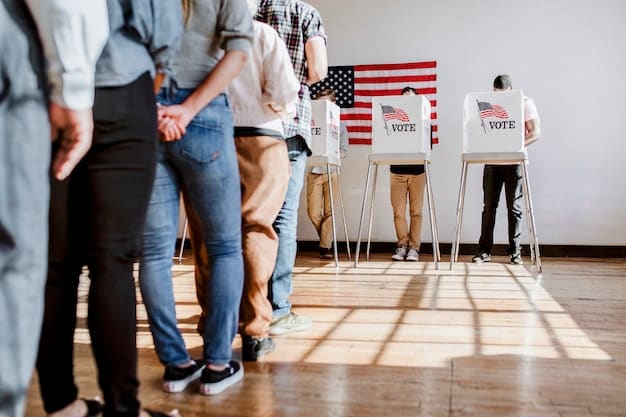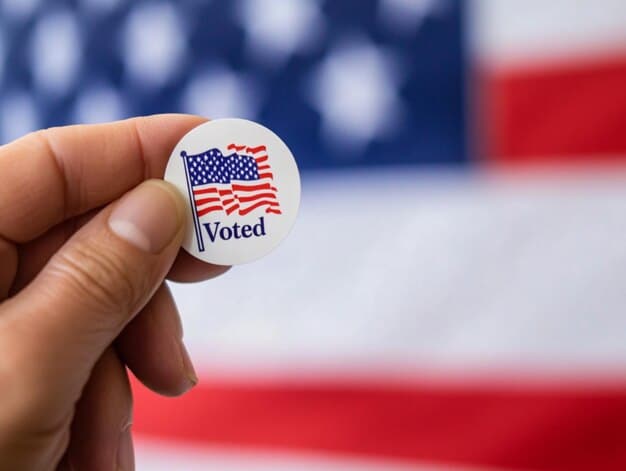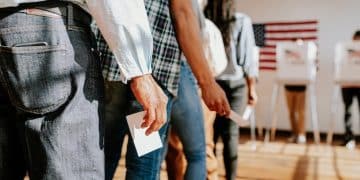US Voting Rights: Proposed Changes & Impact on 2026 Elections

What are the new proposed changes to US voting rights legislation and how could they affect the 2026 midterm elections? Proposed changes to US voting rights legislation aim to modernize voter registration, prevent discriminatory practices, and increase election security, potentially boosting participation and shaping the outcomes of the 2026 midterm elections.
The landscape of voting rights in the United States is constantly evolving, with new legislative proposals frequently debated and implemented. Understanding what are the new proposed changes to US voting rights legislation and how could they affect the 2026 midterm elections is essential for all citizens.
The Current State of US Voting Rights Legislation
The foundation of voting rights in the US is built upon constitutional amendments and federal laws, however understanding the current state of voting rights legislation is crucial to grasping the significance of new proposed changes.
Key Federal Laws
Several key federal laws underpin voting rights in the US. These laws aim to ensure fair and equal access to the ballot box for all citizens.
- The Voting Rights Act of 1965: This landmark legislation prohibits racial discrimination in voting.
- The National Voter Registration Act of 1993 (NVRA): Also known as the “Motor Voter Act,” it allows citizens to register to vote when applying for a driver’s license.
- The Help America Vote Act of 2002 (HAVA): Enacted following the 2000 election, HAVA aims to improve election administration and voting systems nationwide.
Recent Challenges and Controversies
Despite these protections,voting rights have faced numerous challenges and controversies in recent years. These challenges often involve attempts to restrict access to voting through various means.

The current voting rights landscape is complex and contentious. While federal laws provide a baseline of protection, state-level actions and ongoing legal battles continue to shape access to the ballot box. Understanding these dynamics is essential to evaluating the potential impact of new proposed changes on future elections.
Overview of Proposed Changes to Voting Rights
In response to perceived vulnerabilities and ongoing debates about election integrity, several new changes to voting rights legislation have been proposed at both the federal and state levels.
Federal Proposals
At the federal level, numerous proposals aim to strengthen voting rights and address concerns about election security. Here are a few examples:
One such proposal is the John Lewis Voting Rights Advancement Act, seek to restore and modernize key provisions of the Voting Rights Act of 1965, which has been weakened by Supreme Court decisions.
The For the People Act, aim to expand voting access, reform campaign finance laws, and strengthen ethics regulations. This bill includes provisions for automatic voter registration, same-day registration, and online voter registration.
State-Level Initiatives
In addition to federal proposals, many states are considering or have already enacted changes to their voting laws. These changes vary widely depending on the state.
- Voter ID Laws: Some states have introduced stricter voter ID requirements, mandating specific forms of photo identification at the polls.
- Restrictions on Early Voting: Some states have reduced the number of early voting days or eliminated weekend voting.
- Mail-In Voting Restrictions: Some states have tightened rules for mail-in voting, such as requiring stricter signature verification or limiting drop box locations.
Changes come with potential consequences, and carefully monitoring the implementation of these changes is essential to understanding their effects on voter participation and election outcomes.
Potential Effects on the 2026 Midterm Elections
The proposed changes to voting rights legislation could have significant effects on the 2026 midterm elections.

Increased Voter Turnout
Proponents of expanding voting access believe that measures such as automatic voter registration and same-day registration can lead to increased voter turnout, particularly among typically underrepresented groups.
These changes could lead to higher participation rates among young voters, minority communities, and low-income individuals, potentially reshaping the electorate and influencing election outcomes.
Decreased Voter Turnout
On the other hand, critics of stricter voting laws argue that measures such as voter ID requirements and restrictions on early voting could disproportionately affect certain demographics, leading to decreased voter turnout.
These demographics could face additional barriers to voting, resulting in lower participation rates and potentially shifting election outcomes in favor of certain parties or candidates.
The Role of Technology
Technology plays an increasingly important role in elections, and proposed changes to voting rights legislation often address issues such as online voter registration, electronic voting machines, and cybersecurity.
Online Voter Registration
Online voter registration has become more widespread in recent years, with many states offering online portals where citizens can register to vote.
Online voter registration can streamline the registration process, making it more convenient and accessible for voters.
Electronic Voting Machines
Electronic voting machines are used in many jurisdictions across the US, but are the subject of debate.
- Security: Electronic voting machines are vulnerable to hacking and manipulation.
- Accuracy: It’s difficult to trust electronic voting machines because of their source codes .
Some states and localities are exploring options such as hand-marked paper ballots and post-election audits to ensure accuracy and transparency.
The Impact on Specific Demographics
Proposed changes to voting rights legislation could affect various demographic groups differently. Understanding these differential impacts is crucial for assessing the fairness and equity of election laws.
Minority Voters
Minority voters have historically faced systemic barriers to voting, including discriminatory laws and practices.
Federal and legal provisions aimed at preventing discrimination have been weakened or challenged, these communities may face new obstacles to exercising their right to vote.
Young Voters
Young voters are a growing demographic with the potential to influence election outcomes, but they often have lower turnout rates compared to older voters.
Expanding online voter registration and offering same-day registration on college campuses could help engage young voters and increase their participation in elections.
Voters with Disabilities
Voters with disabilities may face unique challenges when trying to register and vote.
States and localities are required to provide accessible voting machines and polling places.
The Legal and Political Landscape
The legal and political landscape surrounding voting rights is constantly shifting, with ongoing court battles and partisan debates shaping the future of elections.
Court Challenges
Many states face court challenges to their voting laws, with advocacy groups and civil rights organizations arguing that these laws violate the Constitution or the Voting Rights Act.
Partisan Polarization
Voting rights have become increasingly polarized along partisan lines, with Democrats generally supporting efforts to expand access to the ballot box and Republicans often prioritizing measures to prevent voter fraud.
This polarization makes it difficult to achieve bipartisan consensus on voting rights legislation, as each party seeks to advance its own agenda and gain a political advantage.
As the debate continues, understanding the legal and political dynamics surrounding voting rights is essential for anyone seeking to participate in the democratic process.
| Key Point | Brief Description |
|---|---|
| 🗳️ Proposed Federal Laws | The John Lewis Voting Rights Advancement Act and the For the People Act aim to restore voting protections and expand access. |
| 🆔 State Voter ID Laws | Many states are introducing or enforcing stricter voter ID requirements, needing specific photo IDs. |
| 📧 Mail-In Voting | Restrictions on mail-in voting include tighter signature rules and limits on drop boxes, impacting voter accessibility. |
| 💻 Online Registration | Technology is used to make secure online voter registration. |
Frequently Asked Questions (FAQ)
▼
The John Lewis Voting Rights Advancement Act aims to restore and modernize key provisions of the Voting Rights Act of 1965, which has been weakened by Supreme Court decisions, to prevent racial discrimination in voting.
▼
Stricter voter ID laws can potentially decrease voter turnout, particularly among minority, low-income, and elderly voters who may have difficulty obtaining the required identification.
▼
The For the People Act includes provisions for automatic voter registration, same-day registration, online voter registration, and campaign finance reforms to expand voting access and reduce the influence of money in politics.
▼
Some states argue that restricting mail-in voting is necessary to prevent voter fraud, though evidence of widespread fraud in mail-in voting is minimal. The real reasons may be politically motivated.
▼
Court challenges can significantly influence voting rights by either upholding or striking down contested voting laws, which directly affects the accessibility and fairness of elections.
Conclusion
Understanding the proposed changes to US voting rights legislation and their potential effects on future elections is crucial for ensuring a fair and democratic society. By staying informed and engaged, citizens can help shape the future of voting rights in America.





